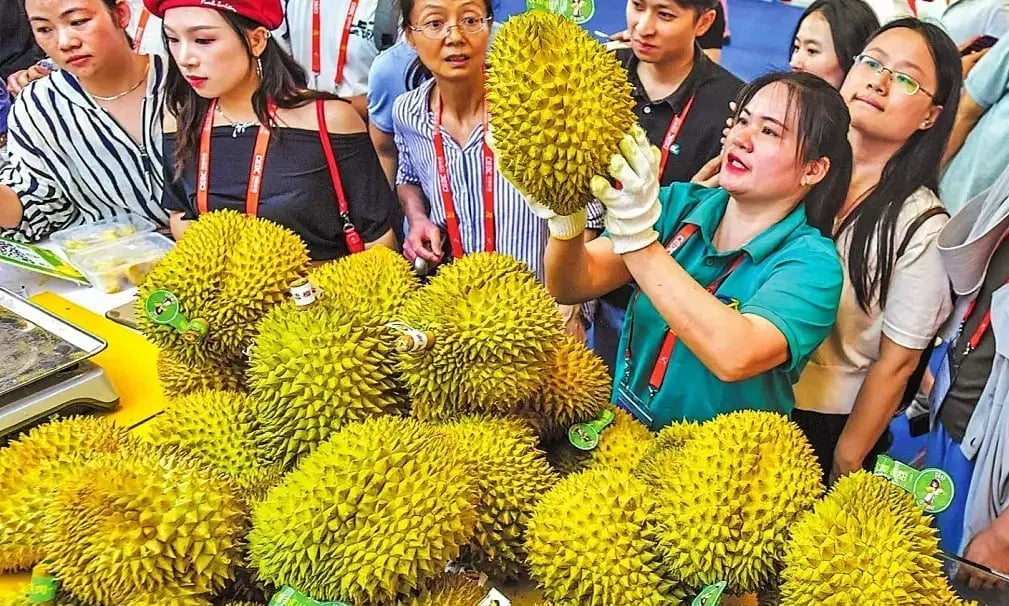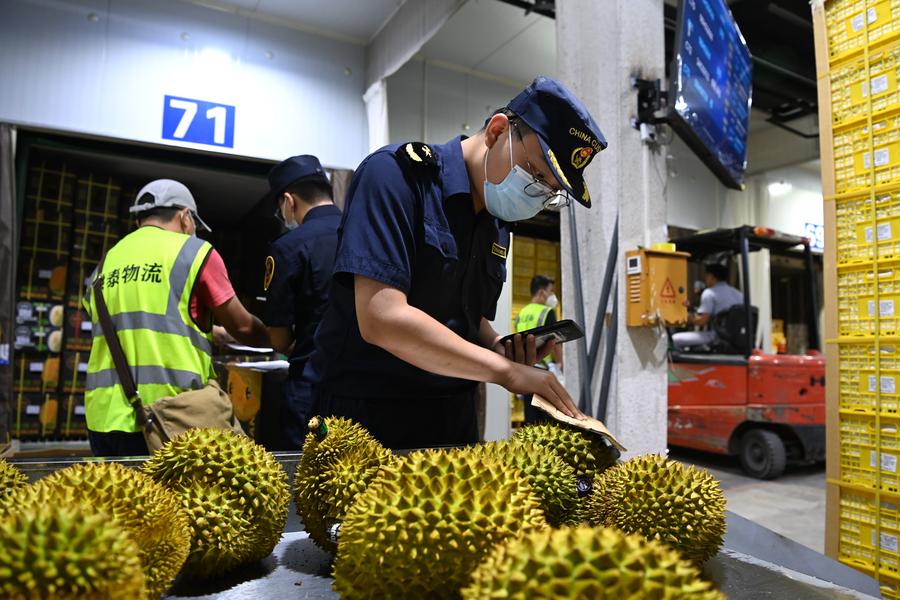October 28, 2025 | 07:02 GMT +7
October 28, 2025 | 07:02 GMT +7
Hotline: 0913.378.918
October 28, 2025 | 07:02 GMT +7
Hotline: 0913.378.918

Vietnamese durians are among the most popular products in Nanning City, Guangxi. Photo: China Daily.
Following the success of the "ASEAN Fruit Gathering in Guangxi: Promoting Convenient and Quality Shopping under RCEP" event series last month, Guangxi continues to emerge as the largest logistics, processing, and transit hub for Southeast Asian fruits in southern China.
Growth signals from import volumes, large-scale fruit procurement contracts, and a series of new investments in cold storage and customs clearance infrastructure have helped turn Guangxi into the golden gateway for tropical fruits entering the Chinese mainland.
According to the Guangxi Department of Commerce, in the first half of 2025, the volume of fruits imported from ASEAN countries through this region reached 780,000 tons, up 50% year-on-year. In June alone, during the promotional campaign, imports hit more than 212,000 tons.
Four key fruits, including durian, mangosteen, lychee, and dragon fruit, accounted for 91.5% of the total volume of ASEAN fruits entering China via Guangxi. Notably, dragon fruit imports soared by 162.8%, with significant contributions from Vietnam, the world’s leading dragon fruit supplier.
As the only Chinese locality that shares both land and maritime borders with ASEAN, Guangxi borders four northern provinces of Vietnam: Quang Ninh, Lang Son, Cao Bang, and Tuyen Quang. Border checkpoints such as Huu Nghi and Pingxiang, Tan Thanh and Po Chai, Mong Cai and Dongxing, and Tra Linh and Long Bang serve as vital arteries for transporting Vietnamese agricultural products and fruits into China.
Data from the General Administration of Customs of China shows that among fruits imported through Guangxi, durians account for the largest share, reaching nearly 180,000 tons in six months, an increase of 47.8% compared to the same period last year.
Vietnam has been one of the biggest beneficiaries of this growth. Its durians have been officially exported to China since mid-2022, and the volume continues to rise. In addition to durians, Vietnam also supplies large volumes of coconuts, mangoes, longans, and rambutans to the Chinese market throughthe Guangxi border crossings.
Guangxi is not only an import point but also the first region to actively invest in processing systems, cold storage, and logistics chains for Southeast Asian fruits. In Nanning, the air-imported fruit quarantine center recorded a 7.2% year-on-year increase in volume.
Meanwhile, in the border city of Chongzuo, which includes the Huu Nghi checkpoint, clusters of cold storage facilities and packing plants for durians and dragon fruits are continuously being put into operation.

Customs officers inspect imported durians in Pingxiang. Photo: Xinhua.
It is estimated that since the "ASEAN Fruit Gathering in Guangxi" event, the Huu Nghi border gate cluster alone has cleared about 38,000 tons of ASEAN fruits, valued at more than 2 billion yuan (USD 280 million).
On the trade side, business linkages between Chinese firms and ASEAN partners, including Vietnam, are increasingly active. In Qinzhou City, enterprises have placed orders for about 20,000 tons of durians, coconuts, and mangoes from Vietnam, Thailand, Malaysia, and Cambodia, totaling more than 5 billion yuan (USD 700 million).
In July alone, over 1,000 containers of durians are expected to continue being imported through Guangxi, with a total value of up to 6 billion yuan (approximately USD 840 million).
Besides transportation and processing, Guangxi is also promoting regional connectivity and building two-way multimodal logistics chains. Chinese fruits such as Sichuan oranges, mandarins, peaches, and Guangxi apples are being exported to ASEAN countries via Qinzhou Port. At the same time, ASEAN fruits imported through Guangxi are being distributed deeper into southwestern Chinese provinces like Yunnan, Guizhou, and Sichuan through wholesale markets and logistics hubs in Nanning.
Guangxi’s proactive strategy in building an ASEAN agricultural trade hub not only shortens customs clearance time and reduces logistics costs, but it also opens up opportunities to expand scale and upgrade the agricultural value chain for exporting countries, with Vietnam being a leading potential partner.
According to the plan, Guangxi will speed up the construction of the China–ASEAN Fruit Trading Center and apply artificial intelligence to digitize the supply chain and monitor the quality of imported fruits. The regional government also aims to make the "ASEAN Fruit Gathering in Guangxi" an annual event that catalyzes branding ASEAN fruits in the billion-consumer market.
The Regional Comprehensive Economic Partnership (RCEP), effective since 2022, is the world’s largest free trade area. It comprises 15 countries including China, Japan, South Korea, Australia, New Zealand, and the 10 ASEAN member states.
RCEP not only reduces tariffs but also simplifies customs procedures and promotes mutual recognition of standards. This enables agricultural products, especially fruits, to move more efficiently and at lower costs within the region.
With close geographic proximity to China and abundant tropical fruit production, Asean countries such as Vietnam, Thailand, and the Philippines are increasingly leveraging RCEP advantages to expand their fruit exports to the vast Chinese market.
Translated by Huong Giang

(VAN) Building on its leading position, Ho Chi Minh City drives a green, digital, and creative wood industry toward global reach and its goal of joining the world’s top 100 most livable cities by 2045.
/2025/10/25/0325-1-nongnghiep-130321.jpg)
(VAN) The 2024–2025 crop year of Viet Nam's coffee industry has ended with record export turnover of USD 8.4 billion. Since the beginning of this year, exports have already surpassed USD 7 billion.

(VAN) Vietnam and Chile are seeing opportunities to deepen their agricultural cooperation, especially as both share a common vision of sustainable development and trade integration.

(VAN) Strong export growth across industries drives Phu Tho’s economic breakthrough and contributes to achieving overall growth goals.

(VAN) During the first 7 months of 2025, Russia boosted its share of Chinese poultry imports to a record 18%, up from 14% the previous year.

(VAN) By October, fruit and vegetable export turnover is estimated to exceed 7 billion USD. This marks the second consecutive year that the sector has surpassed this milestone.

(VAN) Mr. Hamish Marr, New Zealand’s Special Agricultural Trade Envoy, shares experience in developing sustainable, transparent, and value-added agricultural export chains.